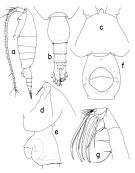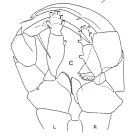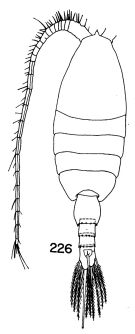|
|
 |
Fiche d'espèce de Copépode |
|
|
Calanoida ( Ordre ) |
|
|
|
Arietelloidea ( Superfamille ) |
|
|
|
Heterorhabdidae ( Famille ) |
|
|
|
Heterorhabdus ( Genre ) |
|
|
| |
Heterorhabdus spinifer Park, 1970 (F,M) | |
| | | | | | | Syn.: | Heterorhabdus (Heterorhabdus) spinifer : Bradford-Grieve,1999 b (p.86, figs.F,M, Rem., figs.175, 191) | | | | Ref.: | | | Park, 1970 (p.477, 519, figs.F,M); Bradford, 1971 a (p.129); Bowman, 1971 b (p.44, Rem.); Park, 2000 (p.108, figs.F,M, Rem.); Vives & Shmeleva, 2007 (p.307, figs.F,M, Rem.) |  issued from : T. Park in Bull. Scripps Inst. Oceanogr. Univ. California, San Diego, 2000, 31. [p.228, Fig.76]. Female: a, habitus (left side); b, urosome (dorsal); c, d, forehead (dorsal, left, respectively); e, f, genital somite (left, ventral, respectively); g, left Mx2 (posterior). Nota: Prosome length 71 % length of body and about 2.3 times length of urosome. Forehead produced anteriad into a small spiniform process and ventrad into a small rostrum bearing 2 slender filaments. - Mx2 falcate spine (fig.76 g) of 5th lobe with proximal 68 % of medial margin serrated with spinules; falcate spine of 6th lobe with proximal 73 % of medial margin serrated with spinules. (Compare with H. prolatus fig.79 a and H. guineanensis fig.72 i).
|
 issued from : T. Park in Bull. Scripps Inst. Oceanogr. Univ. California, San Diego, 2000, 31. [p.229, Fig.77]. Female: a, exopod of P1 (anterior); b, P5 (anterior). Male: c, right P5 (with exopod omitted), anterior; d, basipod of left P5 (anterior); e, exopod of right P5 (anterior); f, right P5 (with endopod omitted), posterior; g, left P5 (with endopod omitted), anterior; h, exopod of left P5 (anterior).
|
 issued from : J.M. Bradford-Grieve in The Marine Fauna of New Zealand: Pelagic Calanoid Copepoda. National Institute of Water and Atmospheric Research (NIWA). NIWA Biodiversity Memoir, 111, 1999. [p.86, Fig.54]. Female: A, P5. Male: B, forehead (dorsal).
|
 issued from : J.M. Bradford-Grieve in The Marine Fauna of New Zealand: Pelagic Calanoid Copepoda. National Institute of Water and Atmospheric Research (NIWA). NIWA Biodiversity Memoir, 111, 1999. [p.86, Fig.54]. Male: C, P5 (L = left leg; R = right leg)
|
 Issued from : T. S. Park in Bull. Mar. Sc., 1970, 20 (2). [p.518, Fig.226]. Female (from Caribbean Sea & G. of Mexico): 226, habitus (dorsal). Nota: Head and 1th toracic segment separate, 4th and 5th fused. Caudal rami asymmetrical, left larger with 2nd median seta thick and elongated.
|
 Issued from : T. S. Park in Bull. Mar. Sc., 1970, 20 (2). [p.520, Figs.227-237]. Female: 227, forehead (lateral); 228, posterior part of metasome and urosome (lateral left side); 229, right Md (biting edge of the mandibular blade); 230, left Md (idem); 231, Mx1; 232, Mx2; 233, Mxp; 234, P1 (anterior). Nota: Anterior forehead produced into a sharp point. mx1: 2nd inner lobe and basis each with 1 seta; endopod with 3 setae. Male: 235, habitus (dorsal); 236, forehead (lateral); 237, P5 (anterior). Nota: Left A1 geniculated. Mouthparts and P1-P4 as in female. P5: basis with a lamelliform inner process fringed with hairs, the process on right basis much higher; 2nd exopodal segment of right P5 with a large, characteristic inner projection.
|
 Heterorhabdus spinifer Heterorhabdus spinifer female: 1 - See key to species groups of Heterorhabdus: ''papilliger'' Group (p.90, 102). 2 - Midanterior tubercular process of forehead produced into a spiniform process (Fig.76-d).P5 without inner marginal seta on 1st endopodal segment (Fig.77-b).
|
 Heterorhabdus spinifer Heterorhabdus spinifer male: 1 - See key to species groups of Heterorhabdus: ''papilliger'' Group (p.90, 102). 2 - Midanterior tubercular process of forehead produced into a spiniform process. Basal inner lobe of left P5 large, rounded distally (Fig.77-g).
| | | | | Ref. compl.: | | | Deevey & Brooks, 1977 (p.256, tab.2, Station "S"); Carter, 1977 (1978) (p.36); Schnack-Schiel & al., 2010 (p.2064, Table 2: E Atlantic subtropical/tropical); Medellin-Mora & Navas S., 2010 (p.265, Tab. 2) | | | | NZ: | 7 | | |
|
Carte de distribution de Heterorhabdus spinifer par zones géographiques
|
| | | | | | | | |  Carte de 1996 Carte de 1996 | |
| | | | Loc: | | | South Africa (E & W), off NE Tristan da Cunha, Caribbean Sea, Caribbean Colombia, G. of Mexico, off Bermuda (Station "S"), Sargasso Sea, off Delaware, W Medit. (in Kovalev & Shmeleva, 1982, p.84), Natal, S Indian (E-W), S Pacif. tropical (E-W), off NE New Zealand.
Locality type: Caribbean Sea and Gulf of Mexico.
For Park (2000, p.109)The species has a circumglobal distribution. In the Indo-Pacific, the species seems to be restricted mainly to the southern tropical regions, while it occurs widely in the Atlantic. | | | | N: | 9 | | | | Lg.: | | | (88) F: 1,72-1,58; M: 1,72-1,6; (399) F: 1,8; M: 1,75; (824) F: 1,9-1,6; M: 2,02-1,64; {F: 1,58-1,90; M: 1,60-2,02} | | | | Rem.: | "Papilliger" Group.
épi-méso-bathypélagique.
Bowman doute de la validité de cette espèce qu'il considère comme un synonyme de H. papilliger.
Voir aussi les remarques en anglais | | | Dernière mise à jour : 14/06/2022 | |
|
|
 Toute utilisation de ce site pour une publication sera mentionnée avec la référence suivante : Toute utilisation de ce site pour une publication sera mentionnée avec la référence suivante :
Razouls C., Desreumaux N., Kouwenberg J. et de Bovée F., 2005-2025. - Biodiversité des Copépodes planctoniques marins (morphologie, répartition géographique et données biologiques). Sorbonne Université, CNRS. Disponible sur http://copepodes.obs-banyuls.fr [Accédé le 30 novembre 2025] © copyright 2005-2025 Sorbonne Université, CNRS
|
|
 |
 |









